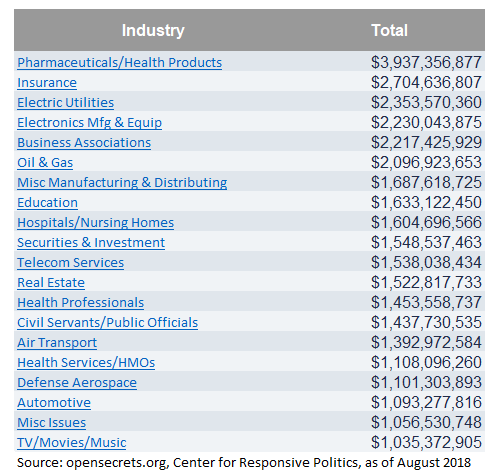In the American political system, lobbying is par for the course. It has come to be expected that major industries, and the leading corporations in those industries, will seek to influence legislation, regulation and the enforcement of government decisions, such that they receive preferential treatment. This could come in the form of campaign contributions, or actual lobbying, with a lobbyist working on behalf of the corporation that has paid them to influence a particular vote, or governmental decision. What it is they are lobbying for, though, is a more involved question.
Here, using data from opensecrets.org, we break down lobbying efforts, industry by industry, combining all political contributions and lobbying spending from 1998-2018, in order to better understand how much each industry and corporation spend in lobbying, and what each of them is lobbying for. (Read more here: Money and Politics)
Pharmaceuticals/Health Products: $3,937,356,877
Spending $3.9 billion over the past 20 years, the pharmaceutical and health products industry has far outpaced all other industries in lobbying spending. It's important to note that this industry includes not only drug manufacturers, but also the sellers of medical products and nutritional and dietary supplements. In 2018, spending was topped by the Pharmaceutical Research and Manufacturers of America and Pfizer.
Overall, the industry is primarily concerned with "resisting government-run health care, ensuring a quicker approval process for drugs and products entering the market and strengthening intellectual property protections.” In recent years, lobbying has focused more specifically “on the patent system, research funding and Medicare.” As is to be expected, lobbying efforts reached a fever pitch in 2009, around the drafting of the Affordable Care Act (ACA) and reported a high in 2017 with legislative enactments again focusing on changes to health care.
Insurance: $2,704,636,807
Including health, property and car insurance companies, agents and brokers, the insurance industry has historically been the second most generous/aggressive industry in lobbying for their interests. In 2017, spending was $160.5 million. Following the passage of the ACA and subsequent developments under the Trump Administration, health insurance companies have been very involved in the legislative process, looking to influence new regulations. In 2018, the leading insurance industry lobbyist corporation was Blue Cross Blue Shield.
Electric Utilities: $2,353,570,360
The electronic utilities industry monitors legislative and regulatory action taken on a number of fronts, including clean air regulation, waste storage, cybersecurity and infrastructure. The top lobbyist in electric utilities as of Oct. 2018 is Southern Company.
Electronics Manufacturing and Equipment: $2,230,043,875
These are your classic software and hardware computer tech companies, some of the founders of the tech movement that exists today. As this industry has become increasingly profitable, its political contributions have increased. The industry is relatively non-partisan, usually giving to each party evenly, with slight favoring to the party in the White House. Given the ubiquity of hardware and software, and tech more generally, it makes sense that lobbying from this industry is varied, with lobbying efforts on homeland security, taxes, copyright, immigration, human rights, cybersecurity and law enforcement data storage. The top lobbying spender was Microsoft in 2018.
Business Associations: $2,217,425,929
This grouping includes small business, pro-business and international trade associations, as well as chambers of commerce. Business associations lobby on issues like labor regulations, intellectual property, product safety and taxes, but mostly, lobbying efforts have focused on civil justice system reform. Business associations want to make sure that damages awarded to plaintiffs involving torts or wrongful acts that led to legal liabilities are limited (asbestos, medical malpractice, etc.). Other important issues also include business tax reform, including corporate tax policy and taxation of U.S. subsidiaries of foreign companies. The top business association lobbyist in 2018 was the U.S Chamber of Commerce.
Oil & Gas: $2,096,923,653
As you might imagine, the oil and gas lobbying sector is one of the most active lobbying groups. Lobbyist efforts have historically focused on promoting legislators with pro-energy views in the areas of fossil fuel production, and commodity exploration and extraction. In 2018, the top lobbying spenders in the industry have been Exxon and Chevron.
Miscellaneous Manufacturing and Distributing: $1,687,618,725
With spending of nearly $1.7 billion in lobbying efforts, miscellaneous manufacturing and distributing is an influential force in legislation and governmental regulation. The sector has members like Honeywell International, General Electric, Cummins Inc., 3M, and Procter & Gamble, and its lobbying interests and efforts reflect this wide array. Having spent $3.8 million in 2018, the National Association of Manufacturers is the industry’s top lobbyist.
Education: $1,633,122,450
Political contributions and lobbying efforts from the education industry come mostly from individual educators or administrators, as educational institutions are not usually able to form PACs. Areas of interest for educators and education lobbyists include the federal budget (allocations for research money, programs, and student aid) and student loans, and specifically the Student Loan Fairness Act, which prevented student loans from doubling when the congressional agreement expired. The top lobbying spender in 2018 is the Association of American Medical Colleges, spending $2.5 million.
Hospitals/ Nursing Homes: $1,604,696,566
This category includes all healthcare institutions - hospitals, nursing homes, hospice providers, and drug and alcohol inpatient centers. Lobbying in this industry was especially active in 2009 and again in 2017 with legislative actions involving health care and the Affordable Care Act. At present, lobbyist efforts in the sector are generally focused on cost management, insurance allocations, spending on employee training, prevention of physician pay reductions, and costs associated with Medicaid and Medicare. The leading spender in 2018 is the American Hospital Association, with $11.4 million.
(Read more here: Why Lobbying Is Legal and Important in the U.S.)

:max_bytes(150000):strip_icc()/100535579-5bfc397346e0fb0026054b7e.jpg)
:max_bytes(150000):strip_icc()/risk_management_-5bfc2f11c9e77c0026b5a067.jpg)
:max_bytes(150000):strip_icc()/shutterstock_180974216-5bfc3652c9e77c005181ecc4.jpg)
:max_bytes(150000):strip_icc()/zombies-5bfc3bcac9e77c0026b93310.jpg)
:max_bytes(150000):strip_icc()/shutterstock_67023106-5bfc2b9846e0fb005144dd87.jpg)
:max_bytes(150000):strip_icc()/business_building_153697270-5bfc2b9846e0fb0083c07d69.jpg)